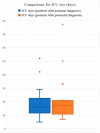Improved Outcomes in Patients with 22q11.2 Deletion Syndrome and Diagnosis of Interrupted Aortic Arch Prior to Birth Hospital Discharge, a Retrospective Study
- PMID: 36672801
- PMCID: PMC9859187
- DOI: 10.3390/genes14010062
Improved Outcomes in Patients with 22q11.2 Deletion Syndrome and Diagnosis of Interrupted Aortic Arch Prior to Birth Hospital Discharge, a Retrospective Study
Abstract
Interruption of the aortic arch (IAA) is a rare but life-threatening congenital heart defect if not corrected in the neonatal period. IAA type B is highly correlated with 22q11.2 deletion syndrome (22q11.2DS); approximately 50% of patients with IAA type B also have 22q11.2DS (Peyvandi et al.; Goldmuntz et al.). Early identification and repair of IAA can prevent severe morbidity and death. However, IAA is challenging to identify prenatally, or even in the neonatal period. In this study, we examined infants with IAA, diagnosed during pregnancy and prior to discharge (PPTD) from the birth hospital vs. those diagnosed following discharge (FD) from the newborn nursery. Our goals were to determine: (1) if early diagnosis improved outcomes; and (2) if patients with IAA and without 22q11.2DS had similar outcomes. In total, 135 patients with a diagnosis of 22q11.2DS and IAA were ascertained through the 22q and You Center at the Children's Hospital of Philadelphia (CHOP). The examined outcomes included: timing of diagnosis; age at diagnosis (days); hospital length of stay (LOS); duration of intensive care unit (ICU) stay; mechanical ventilation (days); duration of inotrope administration (days); year of surgical intervention; birth hospital trauma level; and overall morbidity. These outcomes were then compared with 40 CHOP patients with IAA but without 22q11.2DS. The results revealed that the PPTD neonates had fewer days of intubation, inotrope administration, and hospital LOS when compared to the FD group. The outcomes between deleted and non-deleted individuals with IAA differed significantly, in terms of the LOS (40 vs. 39 days) and time in ICU (28 vs. 24 days), respectively. These results support the early detection of 22q11.2DS via prenatal screening/diagnostics/newborn screening, as IAA can evade routine prenatal ultrasound and postnatal pulse oximetry. However, as previously reported in patients with 22q11.2DS and congenital heart disease (CHD), patients with 22q11.2DS tend to fare poorer compared to non-deleted neonates with IAA.
Keywords: 22q11.2 deletion syndrome; congenital heart disease; critical congenital heart disease screening; interrupted aortic arch; prenatal diagnosis; type B interrupted aortic arch.
Conflict of interest statement
The authors declare no conflict of interest.
Figures




References
-
- Perloff J.K., Marelli A.J. Clinical Recognition of Congenital Heart Disease. Elsevier; Amsterdam, The Netherlands: 2012. Coarctation of the Aorta and Interrupted Aortic Arch; pp. 101–128.
-
- Campbell I.M., Sheppard S.E., Crowley T.B., McGinn D.E., Bailey A., McGinn M.J., Unolt M., Homans J.F., Chen E.Y., Salmons H.I., et al. What is new with 22q? An update from the 22q and You Center at the Children’s Hospital of Philadelphia. Am. J. Med. Genet. Part A. 2018;176:2058–2069. doi: 10.1002/ajmg.a.40637. - DOI - PMC - PubMed
MeSH terms
Substances
Grants and funding
LinkOut - more resources
Full Text Sources
Medical
Research Materials

